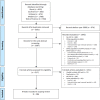Neonatal heart rate variability: a contemporary scoping review of analysis methods and clinical applications
- PMID: 34933863
- PMCID: PMC8710426
- DOI: 10.1136/bmjopen-2021-055209
Neonatal heart rate variability: a contemporary scoping review of analysis methods and clinical applications
Abstract
Background: Neonatal heart rate variability (HRV) is widely used as a research tool. However, HRV calculation methods are highly variable making it difficult for comparisons between studies.
Objectives: To describe the different types of investigations where neonatal HRV was used, study characteristics, and types of analyses performed.
Eligibility criteria: Human neonates ≤1 month of corrected age.
Sources of evidence: A protocol and search strategy of the literature was developed in collaboration with the McGill University Health Center's librarians and articles were obtained from searches in the Biosis, Cochrane, Embase, Medline and Web of Science databases published between 1 January 2000 and 1 July 2020.
Charting methods: A single reviewer screened for eligibility and data were extracted from the included articles. Information collected included the study characteristics and population, type of HRV analysis used (time domain, frequency domain, non-linear, heart rate characteristics (HRC) parameters) and clinical applications (physiological and pathological conditions, responses to various stimuli and outcome prediction).
Results: Of the 286 articles included, 171 (60%) were small single centre studies (sample size <50) performed on term infants (n=136). There were 138 different types of investigations reported: physiological investigations (n=162), responses to various stimuli (n=136), pathological conditions (n=109) and outcome predictor (n=30). Frequency domain analyses were used in 210 articles (73%), followed by time domain (n=139), non-linear methods (n=74) or HRC analyses (n=25). Additionally, over 60 different measures of HRV were reported; in the frequency domain analyses alone there were 29 different ranges used for the low frequency band and 46 for the high frequency band.
Conclusions: Neonatal HRV has been used in diverse types of investigations with significant lack of consistency in analysis methods applied. Specific guidelines for HRV analyses in neonates are needed to allow for comparisons between studies.
Keywords: neonatal intensive & critical care; neonatology; pacing & electrophysiology.
© Author(s) (or their employer(s)) 2021. Re-use permitted under CC BY-NC. No commercial re-use. See rights and permissions. Published by BMJ.
Conflict of interest statement
Competing interests: None declared.
Figures




Similar articles
-
The future of Cochrane Neonatal.Early Hum Dev. 2020 Nov;150:105191. doi: 10.1016/j.earlhumdev.2020.105191. Epub 2020 Sep 12. Early Hum Dev. 2020. PMID: 33036834
-
Beyond the black stump: rapid reviews of health research issues affecting regional, rural and remote Australia.Med J Aust. 2020 Dec;213 Suppl 11:S3-S32.e1. doi: 10.5694/mja2.50881. Med J Aust. 2020. PMID: 33314144
-
Heart rate variability in newborns.Physiol Res. 2017 Sep 22;66(Suppl 2):S203-S214. doi: 10.33549/physiolres.933676. Physiol Res. 2017. PMID: 28937235 Review.
-
Time domain correlation analysis of heart rate variability in preterm neonates.Early Hum Dev. 2005 Apr;81(4):341-50. doi: 10.1016/j.earlhumdev.2004.09.002. Epub 2004 Oct 22. Early Hum Dev. 2005. PMID: 15814218
-
Donkey Heart Rate and Heart Rate Variability: A Scoping Review.Animals (Basel). 2023 Jan 25;13(3):408. doi: 10.3390/ani13030408. Animals (Basel). 2023. PMID: 36766295 Free PMC article.
Cited by
-
Comparing Full and Pre-Term Neonates' Heart Rate Variability in Rest Condition and during Spontaneous Interactions with Their Parents at Home.Healthcare (Basel). 2023 Feb 24;11(5):672. doi: 10.3390/healthcare11050672. Healthcare (Basel). 2023. PMID: 36900677 Free PMC article.
-
Towards precision medicine for extubation of extremely preterm infants: is variability the spice of life?Pediatr Res. 2023 Mar;93(4):748-750. doi: 10.1038/s41390-022-02447-4. Epub 2022 Dec 23. Pediatr Res. 2023. PMID: 36564479 No abstract available.
-
Prediction of outcome of hypoxic-ischemic encephalopathy in newborns undergoing therapeutic hypothermia using heart rate variability.J Perinatol. 2024 Apr;44(4):521-527. doi: 10.1038/s41372-023-01754-w. Epub 2023 Aug 21. J Perinatol. 2024. PMID: 37604967
-
Heart rate variability analysis for the prediction of EEG grade in infants with hypoxic ischaemic encephalopathy within the first 12 h of birth.Front Pediatr. 2023 Jan 4;10:1016211. doi: 10.3389/fped.2022.1016211. eCollection 2022. Front Pediatr. 2023. PMID: 36683815 Free PMC article.
-
Methods for analyzing infant heart rate variability: A preliminary study.Birth Defects Res. 2023 Jun 1;115(10):998-1006. doi: 10.1002/bdr2.2177. Epub 2023 Apr 20. Birth Defects Res. 2023. PMID: 37078641 Free PMC article.
References
-
- Kamath MV, Watanabe MA, Upton A. Heart rate variability (HRV) signal analysis: clinical applications. Boca Raton, Florida: CRC Press, 2012.
-
- Matić V, Cherian PJ, Widjaja D. Heart rate variability in newborns with hypoxic brain injury. Oxygen Transport to Tissue XXXV: Springer, 2013: 43–8. - PubMed
Publication types
MeSH terms
LinkOut - more resources
Full Text Sources
Research Materials
